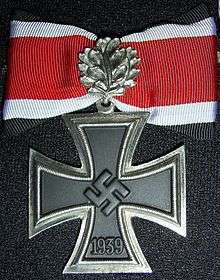Rudolf Holste
| Rudolf Holste | |
|---|---|
| Born |
9 April 1897 Hessisch Oldendorf |
| Died |
4 December 1970 (aged 73) Baden-Baden |
| Allegiance |
|
| Service/branch | Heer |
| Years of service | 1914–45 |
| Rank | Generalleutnant |
| Commands held |
14th Infantry Division 4. Kavallerie-Division XLI Panzer Corps |
| Battles/wars |
World War II |
| Awards | Knight's Cross of the Iron Cross with Oak Leaves |
Rudolf Holste (9 April 1897 – 4 December 1970) was a German general officer (Generalleutnant) in the Wehrmacht during World War II. He was a recipient of the Knight's Cross of the Iron Cross with Oak Leaves of Nazi Germany. Holste commanded the XLI Panzer Corps during the Battle of Berlin, allegedly abandoning his troops on 1 May 1945, one day before the city capitulated.
Career
Holste joined the German Army on in August 1914 and was commissioned as an officer in 1915. During World War II, he commanded 14th Infantry Division, the 4th Cavalry Division and the XLI Panzer Corps. On 20 April 1945 he was promoted to lieutenant general (Generalleutnant).
Battle of Berlin
On 22 April 1945, Holste became part of a poorly conceived and incredibly desperate plan that Wilhelm Keitel and Alfred Jodl proposed to Adolf Hitler. The plan envisaged for the few remaining German forces in central Germany to attack the Soviet forces encircling Berlin. The plan called for General Walther Wenck's Twelfth Army on the Elbe and Mulde fronts to be turned around and to attack towards the east, then linking up just south of Berlin with General Theodor Busse’s Ninth Army. Then both armies would strike in a northeastern direction towards Potsdam and Berlin. Wenck’s objective would be the autobahn at Ferch, near Potsdam.
Holste's directive was to attack from the area northwest of Berlin with his XLI Panzer Corps across the Elbe between Spandau and Oranienburg. To give Holste as much punch as possible, Steiner was to turn over to Holste his mechanized divisions (the 25th Panzer-Grenadiers and the 7th Panzer). Wenck's army did make a turn around and attacked towards Berlin, but was soon halted outside of Potsdam by strong Soviet resistance. Neither Busse nor Holste made much progress towards Berlin. By the end of the day on 27 April, the Soviet forces encircling Berlin linked up and the forces inside Berlin were cut off.
Late in the evening of 29 April, Hans Krebs contacted Jodl by radio from Berlin and requested an immediate report on the whereabouts of Holste's spearhead.[1] On 30 April, Jodl replied that Holste's Corps was on the defensive. Early on the morning of May 1, Holste is reported to have appeared at Twelfth Army HQ having abandoned his troops.[2] A day later, on 2 May, the Battle for Berlin came to an end when Helmuth Weidling unconditionally surrendered the city to the Soviets. Holste surrendered 8 May 1945. In 1947, he was released.
Awards
- Iron Cross (1914) 2nd Class (24 July 1915) & 1st Class (16 November 1917)[3]
- Clasp to the Iron Cross 2nd Class (19 September 1939) & 1st Class (14 October 1939)[3]
- German Cross in Gold on 24 December 1941 as Oberstleutnant in Artillerie-Regiment 73[4]
- Knight's Cross of the Iron Cross with Oak Leaves
- Mentioned in the Wehrmachtbericht (8 August 1944)
References
Citations
- ↑ Zetner, Kurt (1963). Illustrierte Geschichte Des Zweiten Weltkriegs. Munich: Sudwest Verlag. p. 566.
- ↑ Beevor, Antony (2002). The Fall Of Berlin 1945. New York: Viking Penguin Group. p. 379.
- 1 2 Thomas 1997, p. 300.
- ↑ Patzwall & Scherzer 2001, p. 195.
- ↑ Fellgiebel 2000, p. 234.
- ↑ Fellgiebel 2000, p. 87.
Bibliography
- Fellgiebel, Walther-Peer (2000) [1986]. Die Träger des Ritterkreuzes des Eisernen Kreuzes 1939–1945 — Die Inhaber der höchsten Auszeichnung des Zweiten Weltkrieges aller Wehrmachtteile [The Bearers of the Knight's Cross of the Iron Cross 1939–1945 — The Owners of the Highest Award of the Second World War of all Wehrmacht Branches] (in German). Friedberg, Germany: Podzun-Pallas. ISBN 978-3-7909-0284-6.
- Patzwall, Klaus D.; Scherzer, Veit (2001). Das Deutsche Kreuz 1941 – 1945 Geschichte und Inhaber Band II [The German Cross 1941 – 1945 History and Recipients Volume 2] (in German). Norderstedt, Germany: Verlag Klaus D. Patzwall. ISBN 978-3-931533-45-8.
- Scherzer, Veit (2007). Die Ritterkreuzträger 1939–1945 Die Inhaber des Ritterkreuzes des Eisernen Kreuzes 1939 von Heer, Luftwaffe, Kriegsmarine, Waffen-SS, Volkssturm sowie mit Deutschland verbündeter Streitkräfte nach den Unterlagen des Bundesarchives [The Knight's Cross Bearers 1939–1945 The Holders of the Knight's Cross of the Iron Cross 1939 by Army, Air Force, Navy, Waffen-SS, Volkssturm and Allied Forces with Germany According to the Documents of the Federal Archives] (in German). Jena, Germany: Scherzers Miltaer-Verlag. ISBN 978-3-938845-17-2.
- Thomas, Franz (1997). Die Eichenlaubträger 1939–1945 Band 1: A–K [The Oak Leaves Bearers 1939–1945 Volume 1: A–K] (in German). Osnabrück, Germany: Biblio-Verlag. ISBN 978-3-7648-2299-6.
| Military offices | ||
|---|---|---|
| Preceded by Generalleutnant Walther Krause |
Commander of 14. Infanterie-Division 1 January 1943 – 15 May 1943 |
Succeeded by Generalleutnant Hermann Flörke |
| Preceded by Formed from 4. Kavallerie-Brigade |
Commander of 4. Kavallerie-Division 28 February 1945– 29 March 1945 |
Succeeded by Generalleutnant Helmuth von Grolman |
| Preceded by Generalleutnant Wend von Wietersheim |
Commander of XLI Panzer Corps 19 April 1945– 8 May 1945 |
Succeeded by None |
